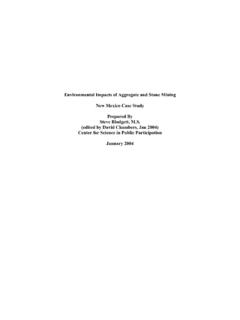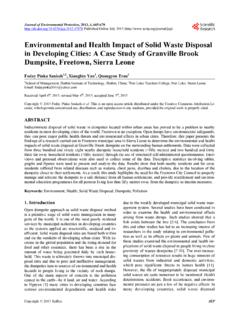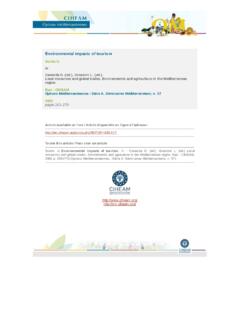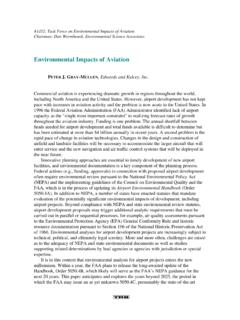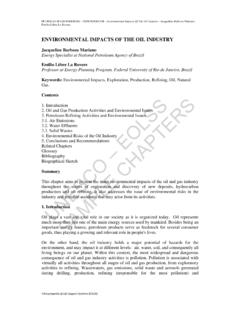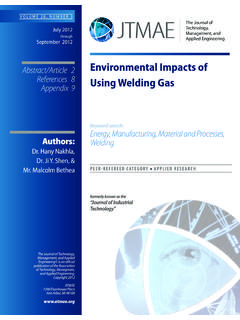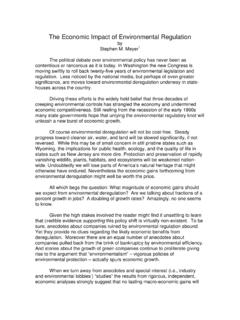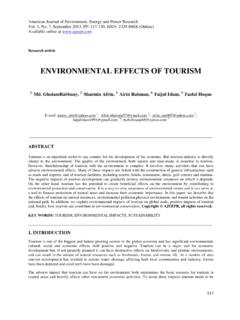Transcription of The Environmental Impacts of - OECD.org
1 Global Forum on Transport and Environment in a Globalising World 10-12 November 2008, Guadalajara, Mexico The Environmental Impacts of Increased International Maritime Shipping Past trends and future perspectives yvind Endresen and Magnus Eide, Det Norske Veritas, H vik, Stig Dals ren and Ivar S. Isaksen, University of Oslo and Eirik S rg rd, Pronord AS, Bod , Norway 2 FOREWORD This paper was prepared by yvind Endresen and Magnus Eide, Det Norske Veritas, H vik, Stig Dals ren and Ivar S. Isaksen, University of Oslo and Eirik S rg rd, Pronord AS, Bod , Norway, as a contribution to the OECD/ITF Global Forum on Transport and Environment in a Globalising World that was held 10-12 November 2008 in Guadalajara, Mexico. The paper discusses the Environmental Impacts of changes in international maritime activity.
2 Minor modifications have been made to the paper in the aftermath of the Global Forum. The views expressed are those of the author, and do not necessarily reflect the views of the OECD or its member countries. Copyright OECD, 2008. Applications for permission to reproduce or translate all or part of this material should be addressed to: Head of Publications Service, OECD, 2 rue Andr -Pascal, 75775 Paris Cedex 16, France 3 4 TABLE OF CONTENTS FOREWORD .. 2 THE Environmental Impacts OF INCREASED INTERNATIONAL MARITIME SHIPPING PAST TRENDS AND FUTURE PERSPECTIVES .. 6 1. Introduction .. 6 2. Quantifying fuel consumption, emissions and Impacts from shipping .. 8 Modelling approach .. 8 Fuel consumption and emissions .. 8 1870-1913 .. 9 1925-2002 .. 10 2002-2007 .. 11 Uncertainties.
3 11 Future ship emissions .. 13 Geographically resolved emission 17 Atmospheric Impacts .. 17 impact on pollution levels and climate .. 18 Future Impacts .. 21 Conclusion .. 22 TABLES .. 24 FIGURES .. 25 REFERENCES .. 37 5 6 THE Environmental Impacts OF INCREASED INTERNATIONAL MARITIME SHIPPING PAST TRENDS AND FUTURE PERSPECTIVES 1. Introduction 1. Increasing pressure is put on industry and businesses, including the various transportation modes, to accomplish sustainable development. Global warming, acidification and degradation of air quality are Environmental impact categories high on the international agenda. Consequently, studies have focused on anthropogenic emissions of compounds leading to such Environmental Impacts : Carbon dioxide (CO2), nitrogen oxides (NOx) and sulphur dioxide (SO2) emissions.
4 Recent studies indicate that the emission of CO2, NOx and SO2 by ship corresponds to about 2-3%, 10-15% and 4-9% of the global anthropogenic emissions, respectively (Corbett and K hler, 2003; Endresen et al., 2003; 2007; Eyring et al., 2005a). Emission inventories are a fundamental input to evaluating the impact of emission on the environment and human health and to guide the policy makers on mitigation options. 2. Regulations and incentives to control pollution sources are often directly aimed at reducing total emissions, typical on a source-by-source basis. Focus is either on sources causing the greatest impact or on the most cost efficient source to control (Corbett and Koehler, 2003). Ship emissions have not previously been regulated, but the International Maritime Organisation (IMO) and EU have recently implemented requirements for ships.
5 A new set of regulations is in process by IMO, EU and US EPA (Dals ren et al., 2007; Eyring et al., 2005b). Focus is mainly on NOx and SO2 emissions, but strategies for CO2 reductions are also considered (International Maritime Organisation (IMO), 2005). 3. Exhaust emissions from a marine diesel engine, the predominant form of power unit in the world fleet, largely comprise of excess carbon dioxide and water vapour with smaller quantities of carbon monoxide, oxides of sulphur and nitrogen, partially reacted and non-combusted hydrocarbons and particulate material (Lloyd s Register of Shipping (LR), 1995). The exhaust gases are emitted into the atmosphere from the ship stacks and diluted through interaction with ambient air. During the dilution process in the ship plume the active chemical compounds are partly transformed and deposited on ground and on water surfaces.
6 Furthermore, during oil transport and cargo handling, evaporation leads to VOC (Volatile Organic Compounds) emissions (Endresen et al., 2003). Shipping also contributes with emission of other compounds ( refrigerants and fire fighting agents), but they are not covered by this study. 4. In order to reduce exhaust emissions, measures can be taken either before the combustion process (fuel oil treatment and fuel oil modifications), during the combustion process (reduce formation of air pollutants in the combustion process) or through after treatment of exhaust gases. The fuel consumption and emissions may also be reduced by improved technical conditions ( antifouling systems, engine efficiency), operational means ( reduced speed, weather routing), alternative fuels ( LNG) and alternative propulsion systems ( fuel cells, sails) (Eyring et al.)
7 , 2005b; Tronstad & Endresen, 2006). Different operational and technical alternatives for reducing cargo VOC emissions ( recovery systems) are available. 5. The main fraction of sulphur dioxide emitted from ships will oxidize in the atmosphere to form sulphate, and nitrogen compounds will form nitric acid and nitrate, and thus contribute to acidification. Sulphate and nitrate aerosols together with directly emitted particles like organic and black carbon might 7 have Impacts on both health and climate. Emissions of nitrogen oxides, carbon monoxide and VOCs will affect pollution levels, especially through enhanced surface ozone formation. Ozone is also an important greenhouse gas and emissions of ozone precursors impact the oxidation of methane (CH4) another important greenhouse gas.
8 Direct emissions of greenhouse gases (CO2 and small amounts of N2O and CH4) change the radiative balance of the atmosphere. There is a significant delay in building up the concentrations of some of the greenhouse gases ( CO2) and thereby in the climate impact . Knowledge on how ship emissions have developed over time is required to quantify climate effects and trends. Since the response time of the climate compounds is very different, ranging from days to centuries, and the chemical interaction between pollutants are highly non-linear, integrated studies estimating more than the impact of one single pollutant will give a better basis to assess the effect of different emission control options. 6. A reliable and up-to-date ship emission inventory is essential when evaluating Impacts , but also when assessing the effect of different emission control options.
9 Shipping activity has increased considerably over the last century (Eyring et al. 2005a; Endresen et al., 2007), and currently represents a significant contribution to the global emissions of greenhouse gases and pollutants, in particularly NOx and SO2 (Corbett et al., 1999; Corbett and Koehler, 2003; Endresen et al., 2003; 2007; Eyring et al., 2005a). Despite this, information about the historical development of fuel consumption and emissions is in general limited, with little data published prior to 1950. There are in addition large deviations reported for estimates covering the last three decades (Endresen et al., 2007). Significant differences are also apparent among the reported present fuel consumption and emission inventories. It is for this reason challenging to evaluate and quantify the Impacts of ship emissions, as well as to propose implementation of effective regulations and incentives for emission reductions.
10 This has led to an ongoing scientific debate regarding past and current levels of emissions and Impacts from ships. The debate revolves around whether bunker sale statistics are representative when estimating fuel based emissions, whether input data on engine operational profiles for different ship types and size categories are representative (Corbett and Koehler, 2003; 2004; Endresen et al., 2003; 2004a; Eyring et al., 2005a), whether the geographical distribution of emissions capture the world fleet traffic (Corbett and Koehler, 2003; Endresen et al., 2003; Dals ren et al., 2007), and whether large scale models might overestimate nitrogen oxides concentrations (Beirle et al., 2004; Chen et al., 2005; Dals ren et al., 2007). A new report from an IMO working group claims that the ship emissions are significantly under-reported (IMO, 2007).











